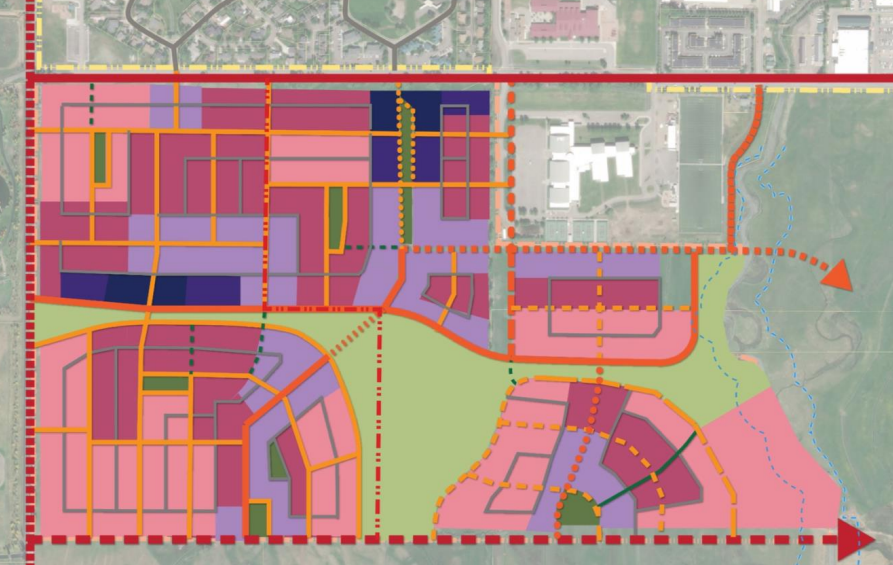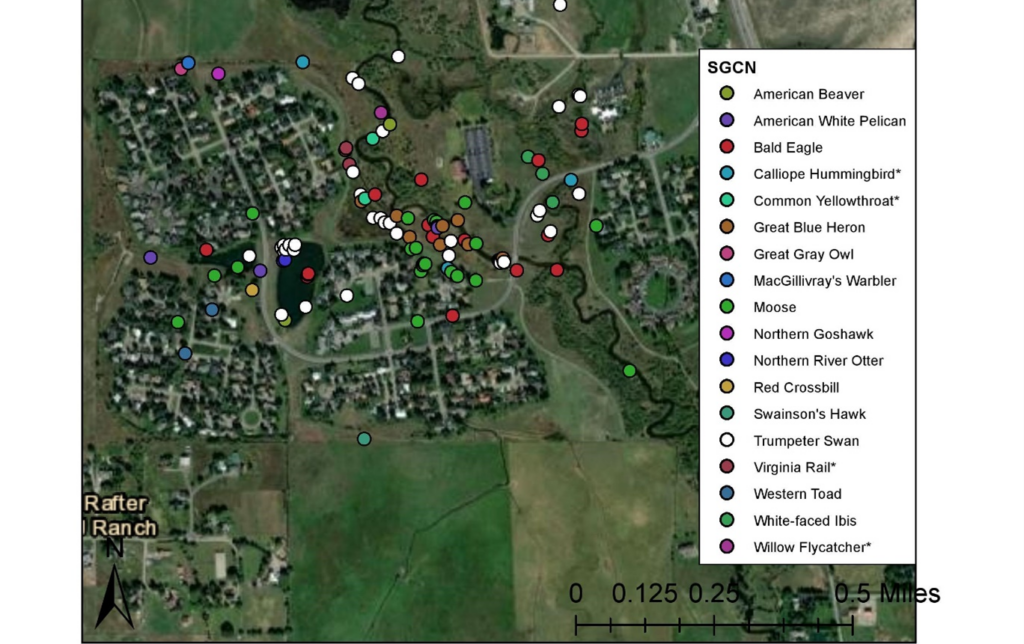By JH Wildlife
What’s in store for Northern South Park
Since 2020, the owners of this land have been engaged with local government and community groups regarding the development of their private property in Northern South Park (NSP). The landowners’ intent is to subdivide and develop a 200+ acre section south of Jackson. An option currently being considered would develop the area densely to accommodate as many as 1,800 housing units (the majority of which would be deed-restricted). Alternatively, the landowners could decide to split the land into 35 acre lots. While exactly how the development plays out is still a bit complicated, what can be expected is the future landscape of NSP is likely to resemble something much different than it does in its current layout of cattle pastures and cottonwood-lined irrigation ditches.

A schematic from the 2022 Neighborhood Plan shows a version of how “passive open space” (light green) might be configured to allow wildlife to move through the development.
How might future development impact wildlife?
Even in scenarios of highest density housing development we anticipate wildlife will use NSP in similar ways to nearby neighborhoods. Although open space will certainly be lost, as agricultural fences come down (including a current 6′ woven and barbed-wire fence which parallels High School Road from the high school to South Park Loop Road) deer and moose will have easier access to the NSP property. New landscaping may increase attractants and potential phasing-out of elk feedgrounds and the termination of elk hazing in NSP may also encourage new movement patterns through the area. Then there’s Flat Creek on the eastern boundary of the proposed development area. Even within the Town of Jackson, Flat Creek serves as an important movement corridor and habitat for everything from beavers, fish and songbirds, to ungulates and other large mammals. Mule deer wintering on the butte across Highway 89 often access this section of Flat Creek for food, water and cover and we expect they will continue to use the creek, even after the buildout of NSP.
So can Northern South Park be developed in a way that reduces the impact on wildlife?
We believe the answer is yes! Currently, Teton County Planning staff are drafting site-specific Land Development Regulations (LDR) and a new zoning overlay in anticipation of NSP buildout. We joined many of our partner organizations in submitting letters to the Planning Commission. While you can read our full letter here, it essentially covers three main recommendations: 1) the application of wildlife-friendly fencing standards, 2) defined Flat Creek setbacks, and 3) protect open space within the developed area to accommodate wildlife movement.
Wildlife-Friendly Fencing Standards: We encouraged the alignment of wildlife-friendly fencing standards in NSP with the current Teton County LDRs to avoid confusion. We also suggested that open spaces and parks remain clear of fencing so as not to entrap wildlife that happens to wander in.

Since 2021, 18 Wyoming Species of Greatest Conservation Need have been reported by JHWF’s Nature Mappers in the Rafter J neighborhood. These data show that the HOA-owned parts of the Flat Creek corridor, as well as the habitat mitigation area, are important for these species. Ideally, NSP would be developed in a similarly responsible way, which would allow for the continued use of the creek corridor by wildlife.
Flat Creek Setbacks: We advised that development not occur within at least 150′ of Flat Creek. A good example of responsible development near Flat Creek is the Rafter J neighborhood. Rafter J’s Flat Creek setbacks, often hundreds of feet in width, are owned and maintained by the Rafter J homeowner association and this protected area supports breeding populations of Wyoming Species of Greatest Conservation Need (WY SGCN) such as Willow Flycatcher and Calliope Hummingbird, along with a large suite of other riparian-associated species. Rafter J also has a habitat mitigation area which supports an impressive community of wetland birds. If NSP can be designed in a similar way, water quality would benefit, as would flood mitigation. This would also help preserve a north to south movement corridor through some of NSPs most valuable habitat.
Open Space: Our recommendation is that NSP design accommodate for wildlife movement through and out of the neighborhood though the preservation of linked, “passive” open space. The NSP Neighborhood Plan, released in 2022, contains sketches of how this open space might be connected and used to allow wildlife passage through the developed area. Ideally, open spaces would maintain a 200-meter minimum width (and larger outside of bottlenecks) based on local research by (Wachob and Smith, 2003). However, if this isn’t practical given the density of the development, these corridors could be combined, to increase width, or laid out near existing open space along the Flat Creek Corridor or southern end of the development area to adjoin with existing open space.

Virginia Rail, another Wyoming Species of Greatest Conservation Need, has been documented breeding in the Rafter J habitat mitigation area. These wetland specialists do not persist outside of intact wetland ecosystems, indicating the health and importance of the Rafter J habitat mitigation area.
If you’re interested in following the development of this issue, the next planning commission meeting is on January 8th! Please let us know if you have any questions or concerns about the process and we’ll answer them to the best of our ability. We are optimistic development can occur in a manner consistent with values outlined in our community’s Comprehensive Plan!
